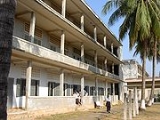
Tuol Sleng Genocide Museum
Encyclopedia
The Tuol Sleng Genocide
Museum is a museum in Phnom Penh
, the capital of Cambodia
. The site is a former high school
which was used as the notorious Security Prison 21 (S-21) by the Khmer Rouge
communist regime from its rise to power in 1975 to its fall in 1979. Tuol Sleng (Khmer
tuəl slaeŋ) means "Hill of the Poisonous Trees" or "Strychnine
Hill".
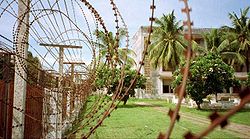
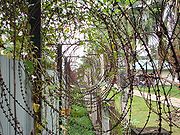
 Formerly the Chao Ponhea Yat High School, named after a Royal ancestor of King Norodom Sihanouk
Formerly the Chao Ponhea Yat High School, named after a Royal ancestor of King Norodom Sihanouk
, the five buildings of the complex were converted in August 1975, four months after the Khmer Rouge won the civil war, into a prison and interrogation center. The Khmer Rouge renamed the complex "Security Prison 21" (S-21) and construction began to adapt the prison to the inmates: the buildings were enclosed in electrified barbed wire, the classrooms converted into tiny prison and torture chambers, and all windows were covered with iron bars and barbed wire to prevent escapes.
From 1975 to 1979, an estimated 17,000 people were imprisoned at Tuol Sleng (some estimates suggest a number as high as 20,000, although the real number is unknown). At any one time, the prison held between 1,000–1,500 prisoners. They were repeatedly tortured and coerced into naming family members and close associates, who were in turn arrested, tortured and killed. In the early months of S-21's existence, most of the victims were from the previous Lon Nol
regime and included soldiers, government officials, as well as academics, doctors, teachers, students, factory workers, monks, engineers, etc. Later, the party leadership's paranoia turned on its own ranks and purges throughout the country saw thousands of party activists and their families brought to Tuol Sleng and murdered. Those arrested included some of the highest ranking communist politicians such as Khoy Thoun, Vorn Vet
and Hu Nim
. Although the official reason for their arrest was "espionage", these men may have been viewed by Khmer Rouge leader Pol Pot
as potential leaders of a coup against him. Prisoners' families were often brought en masse to be interrogated and later murdered at the Choeung Ek
extermination center.
In 1979, the prison was uncovered by the invading Vietnamese army. In 1980, the prison was reopened by the government of the People's Republic of Kampuchea
as a historical museum memorializing the actions of the Khmer Rouge regime.
The museum is open to the public, and receives an average of 500 visitors every day.
The day in the prison began at 4:30 a.m. when prisoners were ordered to strip for inspection. The guards checked to see if the shackles were loose or if the prisoners had hidden objects they could use to commit suicide. Over the years, several prisoners managed to kill themselves, so the guards were very careful in checking the shackles and cells. The prisoners received four small spoonfuls of rice porridge and watery soup of leaves twice a day. Drinking water without asking the guards for permission resulted in serious beatings. The inmates were hosed down every four days.
The prison had very strict regulations, and severe beatings were inflicted upon any prisoner who tried to disobey. Almost every action had to be approved by one of the prison's guards. They were sometimes forced to eat human feces and drink human urine. The unhygienic living conditions in the prison caused skin diseases, lice, rash
es, ringworm and other ailments. The prison's medical staffs were untrained and offered treatment only to sustain prisoners’ lives after they had been injured during interrogation. When prisoners were taken from one place to another for interrogation, their faces were covered. Guards and prisoners were not allowed to converse. Moreover, within the prison, people who were in different groups were not allowed to have contact with one another.
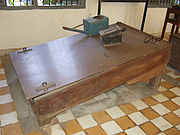
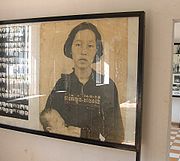
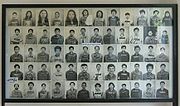
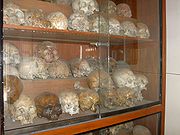 Most prisoners at S-21 were held there for two to three months. However, several high-ranking Khmer Rouge cadres were held longer. Within two or three days after they were brought to S-21, all prisoners were taken for interrogation. The torture system at Tuol Sleng was designed to make prisoners confess to whatever crimes they were charged with by their captors. Prisoners were routinely beaten and tortured with electric shocks, searing hot metal instruments and hanging, as well as through the use of various other devices. Some prisoners were cut with knives or suffocated with plastic bags. Other methods for generating confessions included pulling out fingernails while pouring alcohol on the wounds, holding prisoners’ heads under water, and the use of the waterboarding
Most prisoners at S-21 were held there for two to three months. However, several high-ranking Khmer Rouge cadres were held longer. Within two or three days after they were brought to S-21, all prisoners were taken for interrogation. The torture system at Tuol Sleng was designed to make prisoners confess to whatever crimes they were charged with by their captors. Prisoners were routinely beaten and tortured with electric shocks, searing hot metal instruments and hanging, as well as through the use of various other devices. Some prisoners were cut with knives or suffocated with plastic bags. Other methods for generating confessions included pulling out fingernails while pouring alcohol on the wounds, holding prisoners’ heads under water, and the use of the waterboarding
technique (see picture). Females were sometimes raped by the interrogators, even though sexual abuse was against Democratic Kampuchea (DK) policy. The perpetrators who were found out were executed. Although many prisoners died from this kind of abuse, killing them outright was discouraged, since the Khmer Rouge needed their confessions. The "Medical Unit" at Tuol Sleng, however, did kill at least 100 prisoners by bleeding them to death.
In their confessions, the prisoners were asked to describe their personal background. If they were party members, they had to say when they joined the revolution and describe their work assignments in DK. Then the prisoners would relate their supposed treasonous activities in chronological order. The third section of the confession text described prisoners’ thwarted conspiracies and supposed treasonous conversations. At the end, the confessions would list a string of traitors who were the prisoners’ friends, colleagues, or acquaintances. Some lists contained over a hundred names. People whose names were in the confession list were often called in for interrogation.
Typical confessions ran into thousands of words in which the prisoner would interweave true events in their lives with imaginary accounts of their espionage activities for the CIA, the KGB
, or Vietnam
. The confession of Hu Nim
ended with the words "I am not a human being, I'm an animal". A young Englishman named John Dawson Dewhirst
who was arrested in August 1978 claimed to have joined the CIA at age 12 upon his father receiving a substantial bribe from a work colleague, also an agent. Physical torture was combined with sleep deprivation and deliberate neglect of the prisoners. The torture implements are on display in the museum. It is believed that the vast majority of prisoners were innocent of the charges against them and that the torture produced false confessions.
For the first year of S-21’s existence, corpses were buried near the prison. However, by the end of 1976, cadres ran out of burial spaces, the prisoner and their family were taken to the Choeung Ek
extermination centre, fifteen kilometers from Phnom Penh. There, they were killed by being battered with iron bars, pickaxes, machetes and many other makeshift weapons owing to the scarcity, and subsequent price of ammunition. After the prisoners were executed, the soldiers who had accompanied them from S-21 buried them in graves that held as few as 6 and as many as 100 bodies.
, Thai
, Laotians
, Indians, Pakistan
is, Arabs, Britons
, French
, Americans
, New Zealand
ers and Australia
ns, were also imprisoned.
Almost all non-Cambodians had left the country by early May 1975, following an overland evacuation of the French Embassy in trucks. The few who remained were seen as a security risk. Though most of the foreign victims were either Vietnamese or Thai, a number of Western prisoners, many picked up at sea by Khmer Rouge patrol boats, also passed through S-21 between April 1976 and December 1978. They included four Americans, three French, two Australians, a Briton and a New Zealander. No foreign prisoners survived captivity in Tuol Sleng.
Two Franco-Vietnamese brothers named Rovin and Harad Bernard were detained in April 1976 after they were transferred from Siem Reap
where they had worked tending cattle. Another Frenchman named Andre Gaston Courtigne (30), a former French Embassy employee, was arrested the same month along with his Khmer wife and it is possible that a handful of French nationals who went missing after the 1975 evacuation of Phnom Penh also passed through S-21. Twenty-six year-old John Dawson Dewhirst
, a British Tourist, was one of the youngest foreigners to die in the prison. He was sailing with his New Zealand companion, Kerry Hamill and their Canadian friend Stuart Glass when their boat drifted into Cambodian territory and was intercepted by Khmer patrol boats. Glass was killed during the arrest, while Dewhirst and Hamill were captured, blindfolded, and taken to shore. Both were executed, with Dewhirst possibly being burned alive, after being tortured for several months at Tuol Sleng. Two Americans were captured under similar circumstances. James Clark and Lance McNamara in April 1978 were sailing when their boat drifted off course and sailed into Cambodian waters. They were arrested by Khmer patrol boats, taken ashore, where they were blindfolded, placed on trucks, and taken to the then deserted Phnom Penh.
One of the last foreign prisoners to die was twenty-nine-year old American Michael Scott Deeds, who was captured with his friend Chris De Lance on November 24, 1978 while sailing from Singapore
to Hawaii
. His confession was signed a week before the Vietnamese army invaded Cambodia and ousted the Khmer Rouge.
As of 1999, there were a total of 79 foreign victims on record but former Tuol Sleng Khmer Rouge photographer, Nim Im, claims that the records are not complete. On top of that, there is also an eyewitness accounts of a Cuban
and a Swiss who passed through the prison, though no official records of one was shown.
, Bou Meng and Chim Math, the only woman among the survivors. All three of the men were kept alive because they had skills their captors judged to be useful. Bou Meng, whose wife was killed in the prison, is an artist. Chum Mey was kept alive because of his skills in repairing machinery. Chim Math was held in S-21 for 2 weeks and transferred to the nearby Prey Sar prison
. She may have been spared because she was from Stoeung district in Kampong Thom where Comrade Duch was born. She intentionally distinguished herself by emphasising her provincial accent during her interrogations.
. Other leading figures of S-21 were Khim Vat aka Hor (deputy chief of S-21), Peng (chief of guards), Chan (chief of the Interrogation Unit), and Pon (interrogator). Pon was the person who interrogated important people such as Keo Meas, Nay Sarann, Ho Nim, Tiv Ol, and Phok Chhay.
The documentation unit was responsible for transcribing tape-recorded confessions, typing the handwritten notes from prisoners’ confessions, preparing summaries of confessions, and maintaining files. In the photography sub-unit, workers took mug shots of prisoners when they arrived, pictures of prisoners who had died while in detention, and pictures of important prisoners after they were executed. Thousands of photographs have survived, but thousands are still missing.
The defense unit was the largest unit in S-21. The guards in this unit were mostly teenagers. Many guards found the unit’s strict rules hard to obey. Guards were not allowed to talk to prisoners, to learn their names, or to beat them. They were also forbidden to observe or eavesdrop on interrogations, and they were expected to obey 30 regulations, which barred them from such things as taking naps, sitting down or leaning against a wall while on duty. They had to walk, guard, and examine everything carefully. Guards who made serious mistakes were arrested, interrogated, jailed and put to death. Most of the people employed at S-21 were terrified of making mistakes and feared being tortured and killed.
The interrogation unit was split into three separate groups: Krom Noyobai or political unit, Krom Kdao or 'hot' unit and Krom Angkiem or 'chewing' unit. The hot unit (sometimes called the cruel unit) was allowed to use torture. In contrast, the cold unit (sometimes called the gentle unit) was prohibited from using torture to obtain confessions. If they could not make prisoners confess, they would transfer them to the hot unit. The chewing unit dealt with tough and important cases. Those who worked as interrogators were literate and usually in their 20s.
Some of the staff who worked in Tuol Sleng also ended up as prisoners. They confessed to being lazy in preparing documents, to having damaged machines and various equipment, and to having beaten prisoners to death without permission when assisting with interrogations.
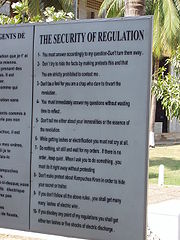 When prisoners were first brought to Tuol Sleng, they were made aware of ten rules that they were to follow during their incarceration. What follows is what is posted today at the Tuol Sleng Museum; the imperfect grammar is a result of faulty translation from the original Khmer:
When prisoners were first brought to Tuol Sleng, they were made aware of ten rules that they were to follow during their incarceration. What follows is what is posted today at the Tuol Sleng Museum; the imperfect grammar is a result of faulty translation from the original Khmer:
During testimony at the Khmer Rouge Tribunal
on April 27, 2009, Duch claimed the 10 security regulations were a fabrication of the Vietnamese officials that first set up the Tuol Sleng Genocide Museum.
The Khmer Rouge required that the prison staff make a detailed dossier for each prisoner. Included in the documentation was a photograph. Since the original negatives and photographs were separated from the dossiers in the 1979–1980 period, most of the photographs remain anonymous today.
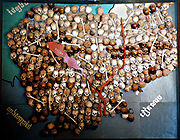
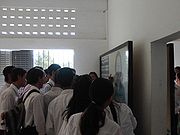 The buildings at Tuol Sleng are preserved as they were left when the Khmer Rouge were driven out in 1979. The regime kept extensive records, including thousands of photographs. Several rooms of the museum are now lined, floor to ceiling, with black and white photographs of some of the estimated 20,000 prisoners who passed through the prison.
The buildings at Tuol Sleng are preserved as they were left when the Khmer Rouge were driven out in 1979. The regime kept extensive records, including thousands of photographs. Several rooms of the museum are now lined, floor to ceiling, with black and white photographs of some of the estimated 20,000 prisoners who passed through the prison.
The site has four main buildings, known as Building A, B, C , and D. Building A holds the large cells in which the bodies of the last victims were discovered. Building B holds galleries of photographs. Building C holds the rooms sub-divided into small cells for prisoners. Building D holds other memorabilia including instruments of torture.
Other rooms contain only a rusting iron bedframe, beneath a black and white photograph showing the room as it was found by the Vietnamese. In each photograph, the mutilated body of a prisoner is chained to the bed, killed by his fleeing captors only hours before the prison was captured. Other rooms preserve leg-irons and instruments of torture. They are accompanied by paintings by former inmate Vann Nath
showing people being tortured, which were added by the post-Khmer Rouge regime installed by the Vietnamese in 1979.
The museum is perhaps best known for having housed the "skull map", a huge map of Cambodia composed of 300 skulls and other bones found by the Vietnamese during their occupation of Cambodia, to serve as a reminder of what happened at the prison. The map was dismantled in 2002, but the skulls of some victims are still on display in shelves in the museum.
Today, the museum is open to the public, and along with the Choeung Ek Memorial
(The Killing Fields
), is included as a point of interest for those visiting Cambodia. Despite the disturbing images it contains, the museum is visited by large parties of Cambodian school children. Some believed that ghosts of the victims continues to haunt the place.
A number of images from Tuol Sleng are featured in the 1992 Ron Fricke
film Baraka
.
, a Cambodian-born, French-trained filmmaker who lost his family when he was 11. The film features two Tuol Sleng survivors, Vann Nath
and Chum Mey, confronting their former Khmer Rouge captors, including guards, interrogators, a doctor and a photographer. The focus of the film is the difference between the feelings of the survivors, who want to understand what happened at Tuol Sleng to warn future generations, and the former jailers, who cannot escape the horror of the genocide they helped create.
Genocide
Genocide is defined as "the deliberate and systematic destruction, in whole or in part, of an ethnic, racial, religious, or national group", though what constitutes enough of a "part" to qualify as genocide has been subject to much debate by legal scholars...
Museum is a museum in Phnom Penh
Phnom Penh
Phnom Penh is the capital and largest city of Cambodia. Located on the banks of the Mekong River, Phnom Penh has been the national capital since the French colonized Cambodia, and has grown to become the nation's center of economic and industrial activities, as well as the center of security,...
, the capital of Cambodia
Cambodia
Cambodia , officially known as the Kingdom of Cambodia, is a country located in the southern portion of the Indochina Peninsula in Southeast Asia...
. The site is a former high school
High school
High school is a term used in parts of the English speaking world to describe institutions which provide all or part of secondary education. The term is often incorporated into the name of such institutions....
which was used as the notorious Security Prison 21 (S-21) by the Khmer Rouge
Khmer Rouge
The Khmer Rouge literally translated as Red Cambodians was the name given to the followers of the Communist Party of Kampuchea, who were the ruling party in Cambodia from 1975 to 1979, led by Pol Pot, Nuon Chea, Ieng Sary, Son Sen and Khieu Samphan...
communist regime from its rise to power in 1975 to its fall in 1979. Tuol Sleng (Khmer
Khmer language
Khmer , or Cambodian, is the language of the Khmer people and the official language of Cambodia. It is the second most widely spoken Austroasiatic language , with speakers in the tens of millions. Khmer has been considerably influenced by Sanskrit and Pali, especially in the royal and religious...
tuəl slaeŋ) means "Hill of the Poisonous Trees" or "Strychnine
Strychnine
Strychnine is a highly toxic , colorless crystalline alkaloid used as a pesticide, particularly for killing small vertebrates such as birds and rodents. Strychnine causes muscular convulsions and eventually death through asphyxia or sheer exhaustion...
Hill".
History



Norodom Sihanouk
Norodom Sihanouk regular script was the King of Cambodia from 1941 to 1955 and again from 1993 until his semi-retirement and voluntary abdication on 7 October 2004 in favor of his son, the current King Norodom Sihamoni...
, the five buildings of the complex were converted in August 1975, four months after the Khmer Rouge won the civil war, into a prison and interrogation center. The Khmer Rouge renamed the complex "Security Prison 21" (S-21) and construction began to adapt the prison to the inmates: the buildings were enclosed in electrified barbed wire, the classrooms converted into tiny prison and torture chambers, and all windows were covered with iron bars and barbed wire to prevent escapes.
From 1975 to 1979, an estimated 17,000 people were imprisoned at Tuol Sleng (some estimates suggest a number as high as 20,000, although the real number is unknown). At any one time, the prison held between 1,000–1,500 prisoners. They were repeatedly tortured and coerced into naming family members and close associates, who were in turn arrested, tortured and killed. In the early months of S-21's existence, most of the victims were from the previous Lon Nol
Lon Nol
Lon Nol was a Cambodian politician and general who served as Prime Minister of Cambodia twice, as well as serving repeatedly as Defense Minister...
regime and included soldiers, government officials, as well as academics, doctors, teachers, students, factory workers, monks, engineers, etc. Later, the party leadership's paranoia turned on its own ranks and purges throughout the country saw thousands of party activists and their families brought to Tuol Sleng and murdered. Those arrested included some of the highest ranking communist politicians such as Khoy Thoun, Vorn Vet
Vorn Vet
Vorn Vet born Pen Thuok, was a deputy prime minister for the economy of Democratic Kampuchea...
and Hu Nim
Hu Nim
Hu Nim, alias "Phoas" was a Cambodian Communistintellectual and politician who held a number of ministerial posts.His long political career included spells with the Sangkum regime...
. Although the official reason for their arrest was "espionage", these men may have been viewed by Khmer Rouge leader Pol Pot
Pol Pot
Saloth Sar , better known as Pol Pot, , was a Cambodian Maoist revolutionary who led the Khmer Rouge from 1963 until his death in 1998. From 1976 to 1979, he served as the Prime Minister of Democratic Kampuchea....
as potential leaders of a coup against him. Prisoners' families were often brought en masse to be interrogated and later murdered at the Choeung Ek
Choeung Ek
Choeung Ek , the site of a former orchard and Chinese graveyard about 17 km south of Phnom Penh, Cambodia, is the best-known of the sites known as The Killing Fields, where the Khmer Rouge regime executed about 17,000 people between 1975 and 1979. Mass graves containing 8,895 bodies were...
extermination center.
In 1979, the prison was uncovered by the invading Vietnamese army. In 1980, the prison was reopened by the government of the People's Republic of Kampuchea
People's Republic of Kampuchea
The People's Republic of Kampuchea , , was founded in Cambodia by the Salvation Front, a group of Cambodian leftists dissatisfied with the Khmer Rouge, after the overthrow of Democratic Kampuchea, Pol Pot's government...
as a historical museum memorializing the actions of the Khmer Rouge regime.
The museum is open to the public, and receives an average of 500 visitors every day.
Life in the prison
Upon arrival at the prison, prisoners were photographed and required to give detailed autobiographies, beginning with their childhood and ending with their arrest. After that, they were forced to strip to their underwear, and their possessions were confiscated. The prisoners were then taken to their cells. Those taken to the smaller cells were shackled to the walls or the concrete floor. Those who were held in the large mass cells were collectively shackled to long pieces of iron bar. The shackles were fixed to alternating bars; the prisoners slept with their heads in opposite directions. They slept on the floor without mats, mosquito nets, or blankets. They were forbidden to talk to each other.The day in the prison began at 4:30 a.m. when prisoners were ordered to strip for inspection. The guards checked to see if the shackles were loose or if the prisoners had hidden objects they could use to commit suicide. Over the years, several prisoners managed to kill themselves, so the guards were very careful in checking the shackles and cells. The prisoners received four small spoonfuls of rice porridge and watery soup of leaves twice a day. Drinking water without asking the guards for permission resulted in serious beatings. The inmates were hosed down every four days.
The prison had very strict regulations, and severe beatings were inflicted upon any prisoner who tried to disobey. Almost every action had to be approved by one of the prison's guards. They were sometimes forced to eat human feces and drink human urine. The unhygienic living conditions in the prison caused skin diseases, lice, rash
Rash
A rash is a change of the skin which affects its color, appearance or texture. A rash may be localized in one part of the body, or affect all the skin. Rashes may cause the skin to change color, itch, become warm, bumpy, chapped, dry, cracked or blistered, swell and may be painful. The causes, and...
es, ringworm and other ailments. The prison's medical staffs were untrained and offered treatment only to sustain prisoners’ lives after they had been injured during interrogation. When prisoners were taken from one place to another for interrogation, their faces were covered. Guards and prisoners were not allowed to converse. Moreover, within the prison, people who were in different groups were not allowed to have contact with one another.
Torture and extermination




Waterboarding
Waterboarding is a form of torture in which water is poured over the face of an immobilized captive, thus causing the individual to experience the sensation of drowning...
technique (see picture). Females were sometimes raped by the interrogators, even though sexual abuse was against Democratic Kampuchea (DK) policy. The perpetrators who were found out were executed. Although many prisoners died from this kind of abuse, killing them outright was discouraged, since the Khmer Rouge needed their confessions. The "Medical Unit" at Tuol Sleng, however, did kill at least 100 prisoners by bleeding them to death.
In their confessions, the prisoners were asked to describe their personal background. If they were party members, they had to say when they joined the revolution and describe their work assignments in DK. Then the prisoners would relate their supposed treasonous activities in chronological order. The third section of the confession text described prisoners’ thwarted conspiracies and supposed treasonous conversations. At the end, the confessions would list a string of traitors who were the prisoners’ friends, colleagues, or acquaintances. Some lists contained over a hundred names. People whose names were in the confession list were often called in for interrogation.
Typical confessions ran into thousands of words in which the prisoner would interweave true events in their lives with imaginary accounts of their espionage activities for the CIA, the KGB
KGB
The KGB was the commonly used acronym for the . It was the national security agency of the Soviet Union from 1954 until 1991, and was the premier internal security, intelligence, and secret police organization during that time.The State Security Agency of the Republic of Belarus currently uses the...
, or Vietnam
Vietnam
Vietnam – sometimes spelled Viet Nam , officially the Socialist Republic of Vietnam – is the easternmost country on the Indochina Peninsula in Southeast Asia. It is bordered by China to the north, Laos to the northwest, Cambodia to the southwest, and the South China Sea –...
. The confession of Hu Nim
Hu Nim
Hu Nim, alias "Phoas" was a Cambodian Communistintellectual and politician who held a number of ministerial posts.His long political career included spells with the Sangkum regime...
ended with the words "I am not a human being, I'm an animal". A young Englishman named John Dawson Dewhirst
John Dawson Dewhirst
John Dawson Dewhirst was a British teacher and amateur yachtsman who was one of nine western adventurers that fell victim of the Khmer Rouge during the genocidal rule of Pol Pot. Dewhirst was one of two Britons to die in Pol Pot's Cambodia....
who was arrested in August 1978 claimed to have joined the CIA at age 12 upon his father receiving a substantial bribe from a work colleague, also an agent. Physical torture was combined with sleep deprivation and deliberate neglect of the prisoners. The torture implements are on display in the museum. It is believed that the vast majority of prisoners were innocent of the charges against them and that the torture produced false confessions.
For the first year of S-21’s existence, corpses were buried near the prison. However, by the end of 1976, cadres ran out of burial spaces, the prisoner and their family were taken to the Choeung Ek
Choeung Ek
Choeung Ek , the site of a former orchard and Chinese graveyard about 17 km south of Phnom Penh, Cambodia, is the best-known of the sites known as The Killing Fields, where the Khmer Rouge regime executed about 17,000 people between 1975 and 1979. Mass graves containing 8,895 bodies were...
extermination centre, fifteen kilometers from Phnom Penh. There, they were killed by being battered with iron bars, pickaxes, machetes and many other makeshift weapons owing to the scarcity, and subsequent price of ammunition. After the prisoners were executed, the soldiers who had accompanied them from S-21 buried them in graves that held as few as 6 and as many as 100 bodies.
Non-Cambodians in the prison
Even though the vast majority of the victims were Cambodian, some foreigners, including VietnameseVietnamese people
The Vietnamese people are an ethnic group originating from present-day northern Vietnam and southern China. They are the majority ethnic group of Vietnam, comprising 86% of the population as of the 1999 census, and are officially known as Kinh to distinguish them from other ethnic groups in Vietnam...
, Thai
Thai people
The Thai people, or Siamese, are the main ethnic group of Thailand and are part of the larger Tai ethnolinguistic peoples found in Thailand and adjacent countries in Southeast Asia as well as southern China. Their language is the Thai language, which is classified as part of the Kradai family of...
, Laotians
Laos
Laos Lao: ສາທາລະນະລັດ ປະຊາທິປະໄຕ ປະຊາຊົນລາວ Sathalanalat Paxathipatai Paxaxon Lao, officially the Lao People's Democratic Republic, is a landlocked country in Southeast Asia, bordered by Burma and China to the northwest, Vietnam to the east, Cambodia to the south and Thailand to the west...
, Indians, Pakistan
Pakistan
Pakistan , officially the Islamic Republic of Pakistan is a sovereign state in South Asia. It has a coastline along the Arabian Sea and the Gulf of Oman in the south and is bordered by Afghanistan and Iran in the west, India in the east and China in the far northeast. In the north, Tajikistan...
is, Arabs, Britons
United Kingdom
The United Kingdom of Great Britain and Northern IrelandIn the United Kingdom and Dependencies, other languages have been officially recognised as legitimate autochthonous languages under the European Charter for Regional or Minority Languages...
, French
France
The French Republic , The French Republic , The French Republic , (commonly known as France , is a unitary semi-presidential republic in Western Europe with several overseas territories and islands located on other continents and in the Indian, Pacific, and Atlantic oceans. Metropolitan France...
, Americans
United States
The United States of America is a federal constitutional republic comprising fifty states and a federal district...
, New Zealand
New Zealand
New Zealand is an island country in the south-western Pacific Ocean comprising two main landmasses and numerous smaller islands. The country is situated some east of Australia across the Tasman Sea, and roughly south of the Pacific island nations of New Caledonia, Fiji, and Tonga...
ers and Australia
Australia
Australia , officially the Commonwealth of Australia, is a country in the Southern Hemisphere comprising the mainland of the Australian continent, the island of Tasmania, and numerous smaller islands in the Indian and Pacific Oceans. It is the world's sixth-largest country by total area...
ns, were also imprisoned.
Almost all non-Cambodians had left the country by early May 1975, following an overland evacuation of the French Embassy in trucks. The few who remained were seen as a security risk. Though most of the foreign victims were either Vietnamese or Thai, a number of Western prisoners, many picked up at sea by Khmer Rouge patrol boats, also passed through S-21 between April 1976 and December 1978. They included four Americans, three French, two Australians, a Briton and a New Zealander. No foreign prisoners survived captivity in Tuol Sleng.
Two Franco-Vietnamese brothers named Rovin and Harad Bernard were detained in April 1976 after they were transferred from Siem Reap
Siem Reap
Siem Reap is the capital city of Siem Reap Province in northwestern Cambodia, and is the gateway to Angkor region.Siem Reap has colonial and Chinese-style architecture in the Old French Quarter, and around the Old Market...
where they had worked tending cattle. Another Frenchman named Andre Gaston Courtigne (30), a former French Embassy employee, was arrested the same month along with his Khmer wife and it is possible that a handful of French nationals who went missing after the 1975 evacuation of Phnom Penh also passed through S-21. Twenty-six year-old John Dawson Dewhirst
John Dawson Dewhirst
John Dawson Dewhirst was a British teacher and amateur yachtsman who was one of nine western adventurers that fell victim of the Khmer Rouge during the genocidal rule of Pol Pot. Dewhirst was one of two Britons to die in Pol Pot's Cambodia....
, a British Tourist, was one of the youngest foreigners to die in the prison. He was sailing with his New Zealand companion, Kerry Hamill and their Canadian friend Stuart Glass when their boat drifted into Cambodian territory and was intercepted by Khmer patrol boats. Glass was killed during the arrest, while Dewhirst and Hamill were captured, blindfolded, and taken to shore. Both were executed, with Dewhirst possibly being burned alive, after being tortured for several months at Tuol Sleng. Two Americans were captured under similar circumstances. James Clark and Lance McNamara in April 1978 were sailing when their boat drifted off course and sailed into Cambodian waters. They were arrested by Khmer patrol boats, taken ashore, where they were blindfolded, placed on trucks, and taken to the then deserted Phnom Penh.
One of the last foreign prisoners to die was twenty-nine-year old American Michael Scott Deeds, who was captured with his friend Chris De Lance on November 24, 1978 while sailing from Singapore
Singapore
Singapore , officially the Republic of Singapore, is a Southeast Asian city-state off the southern tip of the Malay Peninsula, north of the equator. An island country made up of 63 islands, it is separated from Malaysia by the Straits of Johor to its north and from Indonesia's Riau Islands by the...
to Hawaii
Hawaii
Hawaii is the newest of the 50 U.S. states , and is the only U.S. state made up entirely of islands. It is the northernmost island group in Polynesia, occupying most of an archipelago in the central Pacific Ocean, southwest of the continental United States, southeast of Japan, and northeast of...
. His confession was signed a week before the Vietnamese army invaded Cambodia and ousted the Khmer Rouge.
As of 1999, there were a total of 79 foreign victims on record but former Tuol Sleng Khmer Rouge photographer, Nim Im, claims that the records are not complete. On top of that, there is also an eyewitness accounts of a Cuban
Cubans
Cubans or Cuban people are the inhabitants or citizens of Cuba. Cuba is a multi-ethnic nation, home to people of different ethnic and national backgrounds...
and a Swiss who passed through the prison, though no official records of one was shown.
Survivors of Tuol Sleng
Out of an estimated 17,000 people imprisoned at Tuol Sleng, there were only seven known survivors. As of September 2011, only three of them are thought to be still alive: Chum MeyChum Mey
Chum Mey is one of only twelve known survivors of the Khmer Rouge imprisonment in the S-21 Tuol Sleng camp, where more than 16,000 Cambodians were sent for execution. He survived two years of torture and fear in a Khmer Rouge death camp, sustained by thoughts of his pregnant wife and unborn child...
, Bou Meng and Chim Math, the only woman among the survivors. All three of the men were kept alive because they had skills their captors judged to be useful. Bou Meng, whose wife was killed in the prison, is an artist. Chum Mey was kept alive because of his skills in repairing machinery. Chim Math was held in S-21 for 2 weeks and transferred to the nearby Prey Sar prison
Prey Sar prison
The Prey Sar Prison, previously known as S24, is the largest of 24 Cambodian prisons and holds about 500 prisoners. Prey Sar is administrated by the Cambodian Ministry of Interior with liaisons from the Ministry of Health...
. She may have been spared because she was from Stoeung district in Kampong Thom where Comrade Duch was born. She intentionally distinguished herself by emphasising her provincial accent during her interrogations.
Staff of S-21
The prison had a staff of 1,720 people. Of those, approximately 300 were office staff, internal workforce and interrogators. The other 1,400 were general workers, including people who grew food for the prison. Several of these workers were children taken from the prisoner families. The chief of the prison was Khang Khek Ieu (also known as Comrade Duch), a former mathematics teacher who worked closely with Khmer Rouge leader Pol PotPol Pot
Saloth Sar , better known as Pol Pot, , was a Cambodian Maoist revolutionary who led the Khmer Rouge from 1963 until his death in 1998. From 1976 to 1979, he served as the Prime Minister of Democratic Kampuchea....
. Other leading figures of S-21 were Khim Vat aka Hor (deputy chief of S-21), Peng (chief of guards), Chan (chief of the Interrogation Unit), and Pon (interrogator). Pon was the person who interrogated important people such as Keo Meas, Nay Sarann, Ho Nim, Tiv Ol, and Phok Chhay.
The documentation unit was responsible for transcribing tape-recorded confessions, typing the handwritten notes from prisoners’ confessions, preparing summaries of confessions, and maintaining files. In the photography sub-unit, workers took mug shots of prisoners when they arrived, pictures of prisoners who had died while in detention, and pictures of important prisoners after they were executed. Thousands of photographs have survived, but thousands are still missing.
The defense unit was the largest unit in S-21. The guards in this unit were mostly teenagers. Many guards found the unit’s strict rules hard to obey. Guards were not allowed to talk to prisoners, to learn their names, or to beat them. They were also forbidden to observe or eavesdrop on interrogations, and they were expected to obey 30 regulations, which barred them from such things as taking naps, sitting down or leaning against a wall while on duty. They had to walk, guard, and examine everything carefully. Guards who made serious mistakes were arrested, interrogated, jailed and put to death. Most of the people employed at S-21 were terrified of making mistakes and feared being tortured and killed.
The interrogation unit was split into three separate groups: Krom Noyobai or political unit, Krom Kdao or 'hot' unit and Krom Angkiem or 'chewing' unit. The hot unit (sometimes called the cruel unit) was allowed to use torture. In contrast, the cold unit (sometimes called the gentle unit) was prohibited from using torture to obtain confessions. If they could not make prisoners confess, they would transfer them to the hot unit. The chewing unit dealt with tough and important cases. Those who worked as interrogators were literate and usually in their 20s.
Some of the staff who worked in Tuol Sleng also ended up as prisoners. They confessed to being lazy in preparing documents, to having damaged machines and various equipment, and to having beaten prisoners to death without permission when assisting with interrogations.
Security regulations

- 1. You must answer accordingly to my question. Don’t turn them away.
- 2. Don’t try to hide the facts by making pretexts this and that, you are strictly prohibited to contest me.
- 3. Don’t be a fool for you are a chap who dare to thwart the revolution.
- 4. You must immediately answer my questions without wasting time to reflect.
- 5. Don’t tell me either about your immoralities or the essence of the revolution.
- 6. While getting lashes or electrification you must not cry at all.
- 7. Do nothing, sit still and wait for my orders. If there is no order, keep quiet. When I ask you to do something, you must do it right away without protesting.
- 8. Don’t make pretext about Kampuchea Krom in order to hide your secret or traitor.
- 9. If you don’t follow all the above rules, you shall get many lashes of electric wire.
- 10. If you disobey any point of my regulations you shall get either ten lashes or five shocks of electric discharge.
During testimony at the Khmer Rouge Tribunal
Extraordinary Chambers in the Courts of Cambodia
The Extraordinary Chambers in the Courts of Cambodia, commonly known as the "Khmer Rouge Tribunal", is a national court established pursuant to an agreement between the Royal Government of Cambodia and the United Nations to try senior members of the Khmer Rouge for serious violations of Cambodian...
on April 27, 2009, Duch claimed the 10 security regulations were a fabrication of the Vietnamese officials that first set up the Tuol Sleng Genocide Museum.
Discovery of Tuol Sleng
In 1979 Ho Van Tay, a Vietnamese combat photographer, was the first media person to document Tuol Sleng to the world. Van Tay and his colleagues followed the stench of rotting corpses to the gates of Tuol Sleng. The photos of Ho Van Tay documenting what he saw when he entered the site are exhibited in Tuol Sleng today.The Khmer Rouge required that the prison staff make a detailed dossier for each prisoner. Included in the documentation was a photograph. Since the original negatives and photographs were separated from the dossiers in the 1979–1980 period, most of the photographs remain anonymous today.
Tuol Sleng today


The site has four main buildings, known as Building A, B, C , and D. Building A holds the large cells in which the bodies of the last victims were discovered. Building B holds galleries of photographs. Building C holds the rooms sub-divided into small cells for prisoners. Building D holds other memorabilia including instruments of torture.
Other rooms contain only a rusting iron bedframe, beneath a black and white photograph showing the room as it was found by the Vietnamese. In each photograph, the mutilated body of a prisoner is chained to the bed, killed by his fleeing captors only hours before the prison was captured. Other rooms preserve leg-irons and instruments of torture. They are accompanied by paintings by former inmate Vann Nath
Vann Nath
Vann Nath was a Cambodian painter, artist, writer and human rights activist who was one of a diverse group of writers from 22 countries to receive the prestigious Lillian Hellman/Hammett Award which recognizes courage in the face of political persecution which he faced during the Khmer Rouge...
showing people being tortured, which were added by the post-Khmer Rouge regime installed by the Vietnamese in 1979.
The museum is perhaps best known for having housed the "skull map", a huge map of Cambodia composed of 300 skulls and other bones found by the Vietnamese during their occupation of Cambodia, to serve as a reminder of what happened at the prison. The map was dismantled in 2002, but the skulls of some victims are still on display in shelves in the museum.
Today, the museum is open to the public, and along with the Choeung Ek Memorial
Choeung Ek
Choeung Ek , the site of a former orchard and Chinese graveyard about 17 km south of Phnom Penh, Cambodia, is the best-known of the sites known as The Killing Fields, where the Khmer Rouge regime executed about 17,000 people between 1975 and 1979. Mass graves containing 8,895 bodies were...
(The Killing Fields
The Killing Fields
The Killing Fields are a number of sites in Cambodia where large numbers of people were killed and buried by the Khmer Rouge regime, during its rule of the country from 1975 to 1979, immediately after the end of the Cambodian Civil War ....
), is included as a point of interest for those visiting Cambodia. Despite the disturbing images it contains, the museum is visited by large parties of Cambodian school children. Some believed that ghosts of the victims continues to haunt the place.
A number of images from Tuol Sleng are featured in the 1992 Ron Fricke
Ron Fricke
Ron Fricke is an American film director and cinematographer, considered to be a master of time-lapse photography and large format cinematography. He was the director of photography for Koyaanisqatsi and directed the purely cinematic non-verbal non-narrative feature Baraka . He designed and used...
film Baraka
Baraka (film)
Baraka is a 1992 non-narrative film directed by Ron Fricke. The title Baraka is a word that means blessing in a multitude of languages....
.
S-21 documentary movie
S-21: The Khmer Rouge Killing Machine is a 2003 film by Rithy PanhRithy Panh
Rithy Panh is an internationally and critically acclaimed Cambodian documentary film director and screenwriter.The French-schooled director's films focus on the aftermath of the genocidal Khmer Rouge regime in Cambodia...
, a Cambodian-born, French-trained filmmaker who lost his family when he was 11. The film features two Tuol Sleng survivors, Vann Nath
Vann Nath
Vann Nath was a Cambodian painter, artist, writer and human rights activist who was one of a diverse group of writers from 22 countries to receive the prestigious Lillian Hellman/Hammett Award which recognizes courage in the face of political persecution which he faced during the Khmer Rouge...
and Chum Mey, confronting their former Khmer Rouge captors, including guards, interrogators, a doctor and a photographer. The focus of the film is the difference between the feelings of the survivors, who want to understand what happened at Tuol Sleng to warn future generations, and the former jailers, who cannot escape the horror of the genocide they helped create.
Further reading
- Vann Nath: A Cambodian Prison Portrait. One Year in the Khmer Rouge's S-21. White Lotus Co. Ltd., Bangkok 1998, ISBN 974-8434-48-6 (An eyewitness report. The author's paintings of many scenes from the prison are on display in the Tuol Sleng museum today.)
- Chandler, David: Voices from S-21. Terror and history inside Pol Pot's secret prison. University of California Press, 1999. ISBN 0-520-22247-4 (A general account of S-21 drawing heavily from the documentation maintained by the prison's staff.)
- Dunlop, Nic: "The Lost Executioner: A Story of the Khmer Rouge". Walker & Company, 2006. ISBN 0-8027-1472-2 (A first-person encounter with Comrade Duch, who ran S-21. The author's discovery of Duch led to the latter's arrest, and imprisonment.)
- Douglas Niven & Chris Riley: "The Killing Fields". Twin Palms Press, 1996. ISBN 978-0-944092-39-2 (Original photographs from S-21 prison, printed from original negatives by two American photographers.)
External links
- Photographs from S-21 – The original prisoner photographs from Tuol Sleng (S-21).
- The horrors of Tuol Sleng
- Cambodia Tribunal Monitor
- Photographic archive of S-21 prisoners

